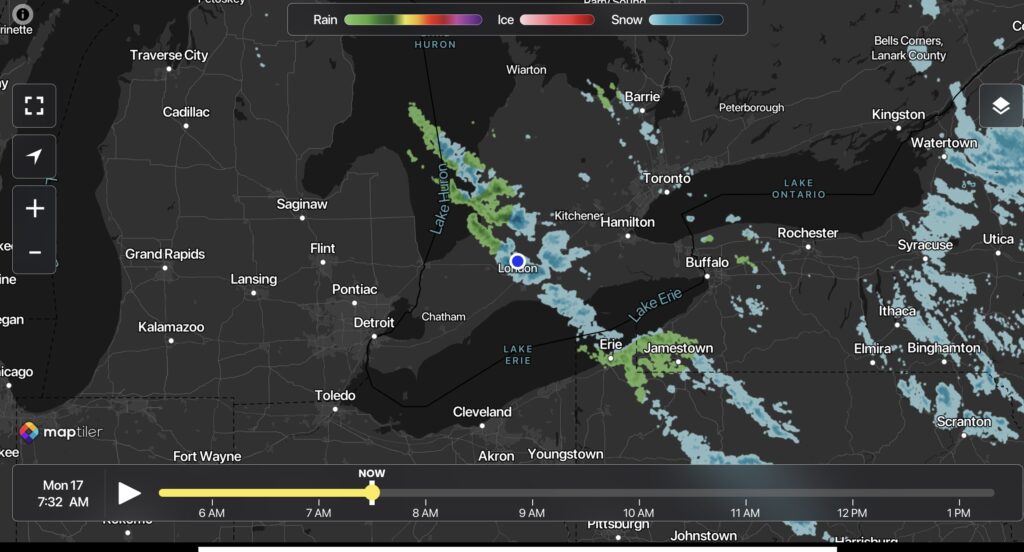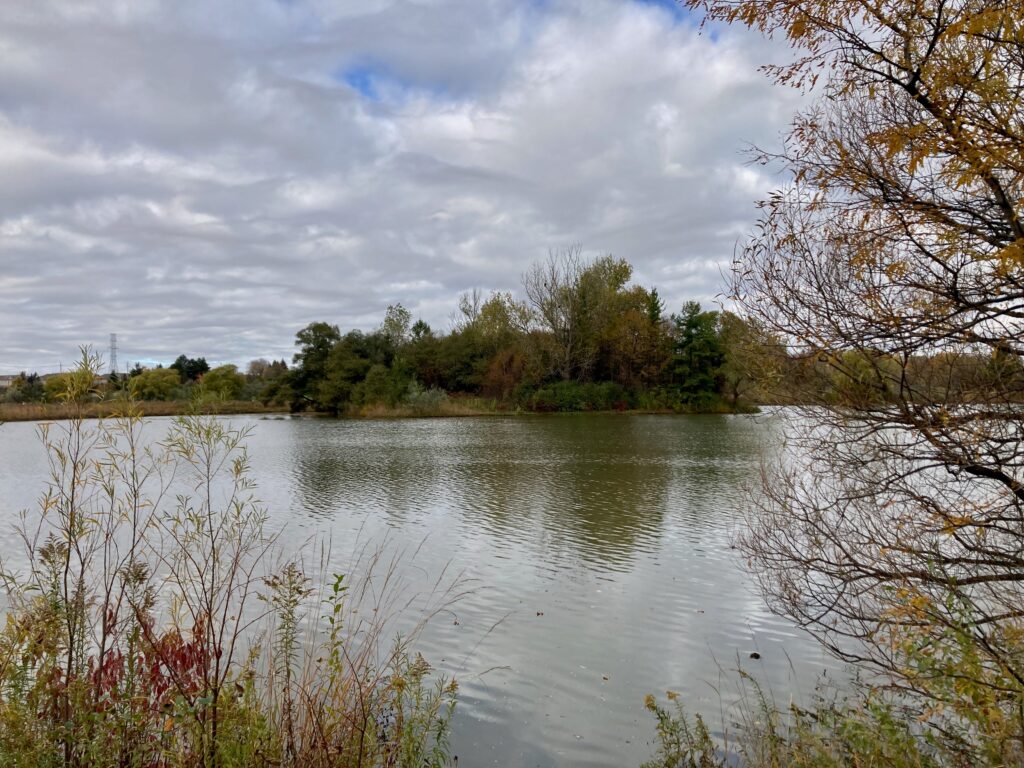Weather Report
This year, London is living up to its “snow belt” reputation. Although last week’s snow had disappeared, more lake-effect snow descended from Lake Huron on November 16th and 17th.


At least, stormy skies bring colourful sunsets.


Lake-effect snow is produced when a cold air mass passes over warmer lake water. The lower layer of air picks up water vapour that rises through the cold air, freezes and is deposited as the cold air mass moves downwind of the lake. London was directly in the path of the air mass as it moved south from Lake Huron.
The weather radar map shows the extent of the storm that passed over us all night.

Columbia Lake
In late October, before the snow and before the leaves fell, we spent a few days in Waterloo. While we were there, a friend took us to walk some nearby trails around Columbia Lake. The “lake” is part of an environmental reserve on the University of Waterloo campus. The man-made reservoir has undergone alterations over the years to create a wetland and allow Laurel Creek to run through it.
We did not have high expectations of seeing many birds at that time of year. As we were exiting our vehicle, however, our sharp-eyed friend spotted two Bald Eagles, one perched in a tree across the lake. As we watched, a second eagle flew in and landed in the tree with a fish dangling from its talons.
Two adult eagles are just visible in the bare branches of the tree across Columbia Lake.





After several minutes, the pair left with the fish.





The lake hosted a few Canada Geese and several female Common Mergansers.




Among the Mallards dozing on the shore, we spotted a handsome male Wood Duck.



A Mallard drake was accompanied by a female with very unusual plumage. Mallards hybridize with other duck species and with domestic ducks, producing many combinations of traits. We hadn’t encountered one quite like this before.


The trail leads through meadowland and woods.




A stream runs through the woods. It attracts migrating and resident birds through the spring and summer. The only song birds in evidence this day were a Northern Cardinal, an elusive Dark-eyed Junco, and a raucous Blue Jay.


Many trees were still in leaf.
Below is a London Plane tree. The London Plane tree can be easily mistaken for a native American Sycamore/Plane tree. Plane trees are thought to be hybrids of American and Oriental Plane trees. The hybrids are often planted in cities as they are more tolerant of urban pollution than Sycamores. There are several differences between American Sycamores and London Plane trees. For example, the seed heads of Plane trees grow in groups of two or three, whereas Sycamores have one seed head per stalk.




Sugar Maples blazed red, even without the sun.



Dogwood and Guelder-Rose bushes added more colour.



Seeds emerging from Milkweed pods were ready to fly.




Eastern Gray Squirrels (that come in black, gray and white variants) were busy foraging.


Brubacher House
The Brubacher farmhouse sits just off the path around Columbia Lake.


The University of Waterloo was built on farmland previously owned by Pennsylvania Deutsch (German) Mennonites. The farmhouse was built in 1850. Magdalena and John E. Brubacher raised fourteen children there. The house was restored with the help of Mennonite craftsmen and now serves as a museum to interpret Mennonite history and culture.
Music of the Bee Gees
We saw the Bee Gees while we were students in Waterloo. They were featuring songs from Saturday Night Fever. I enjoyed the quiet songs where I could hear the vocal harmonies and the lyrics.
I had forgotten just how big the Bee Gees were. They were inducted into the Rock and Roll Hall of Fame in 1997;[13] the Hall’s citation stating at the time, “Only Elvis Presley, the Beatles, Michael Jackson, Garth Brooks and Paul McCartney have outsold the Bee Gees.”
